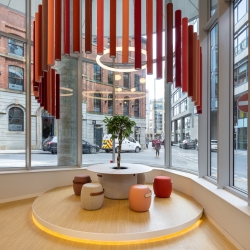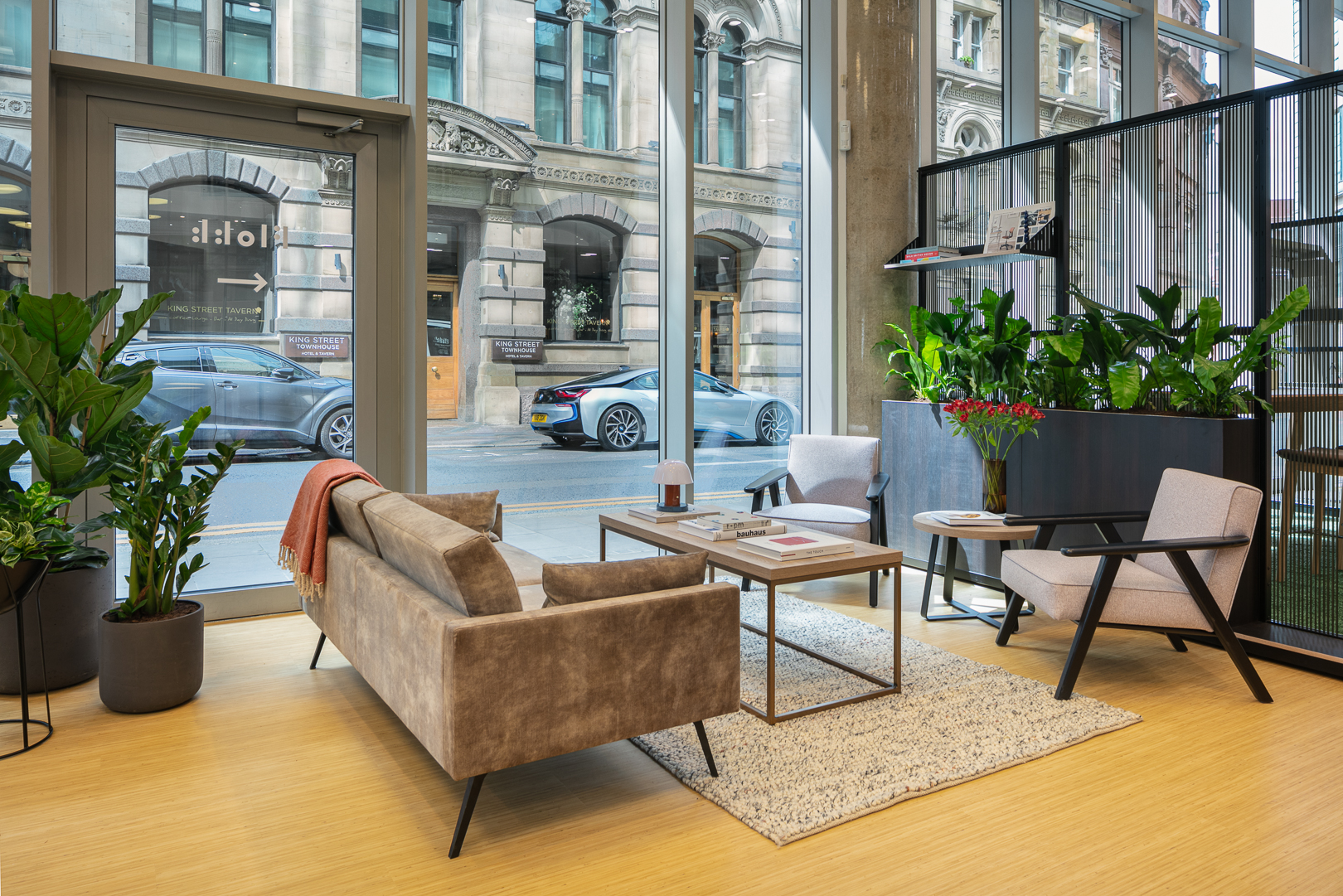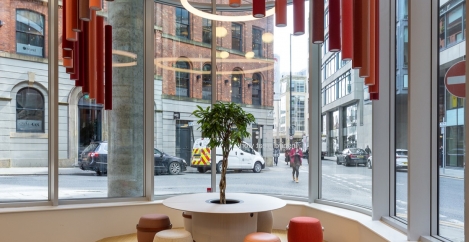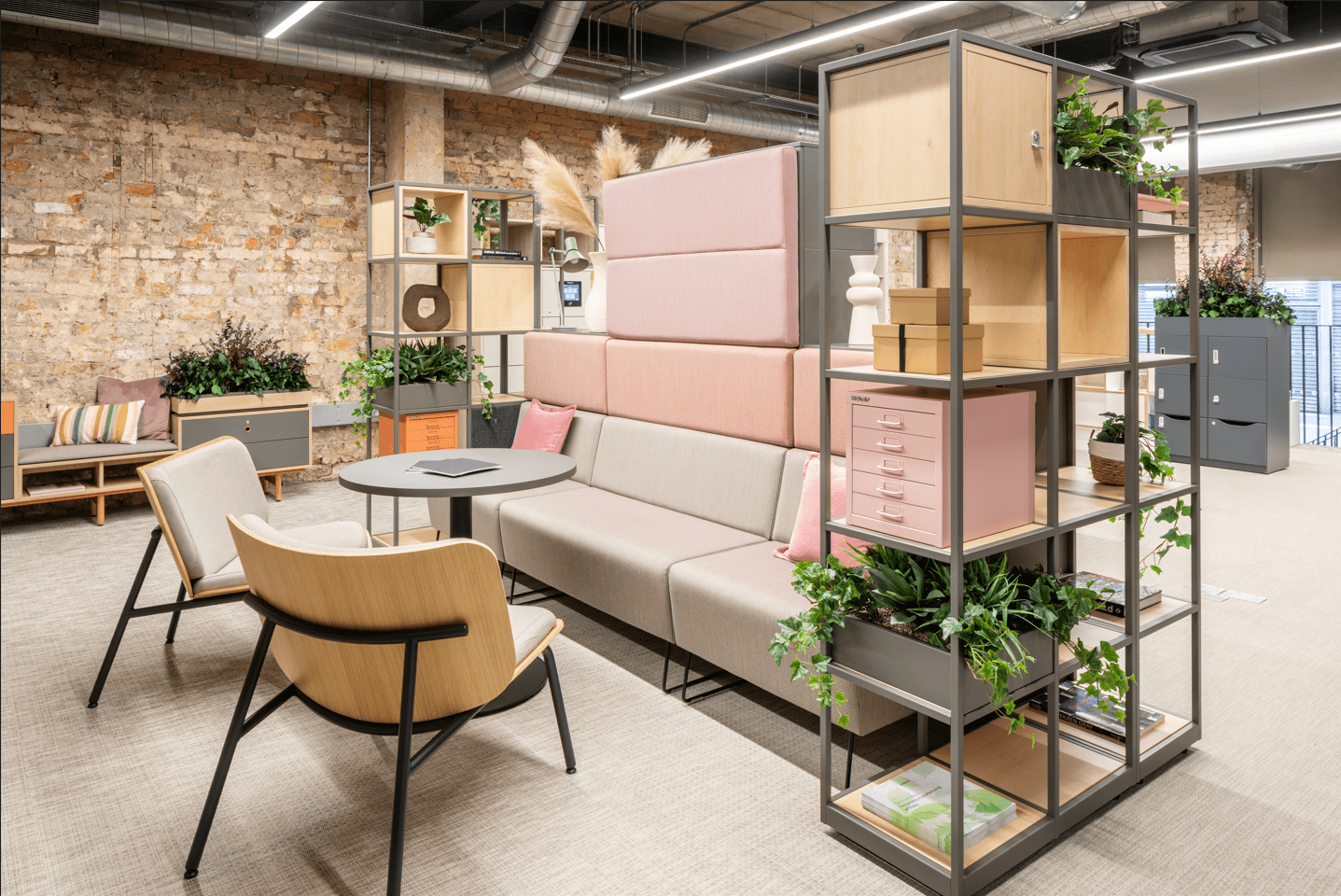November 20, 2023
Manchester is now a major draw for office design firms
 Way before the lockdown rewired the whole events scene in cities around the world, I was given a task by an old, now departed, friend. He wanted to explore the possibility of creating something like Clerkenwell Design Week in Manchester. The obvious problem was that, for some of its historic parallels, Manchester isn’t Clerkenwell and it certainly isn’t London. What it particularly lacked for this type of event was a hothouse of office design showrooms sharing space with a youthful community of architects and designers. The ecosystem for such an event didn’t really exist in the same way.
Way before the lockdown rewired the whole events scene in cities around the world, I was given a task by an old, now departed, friend. He wanted to explore the possibility of creating something like Clerkenwell Design Week in Manchester. The obvious problem was that, for some of its historic parallels, Manchester isn’t Clerkenwell and it certainly isn’t London. What it particularly lacked for this type of event was a hothouse of office design showrooms sharing space with a youthful community of architects and designers. The ecosystem for such an event didn’t really exist in the same way.
An event did emerge from this mission after a few introductions, and it is still going to this day. But it isn’t Manchester Design Week. It was built on different strengths.
This is as it should be. Over many years, Manchester has continued to counter-balance the overbearing weight of London. Its emergence as a city state within the still wildly tribal makeup of the UK is a reminder that not so long ago, it was the rest of the UK that propped up London and the South-East of England, not the other way around.
The symbol of this past might was the Albert Waterhouse designed Town Hall on Albert Square, an imposing gothic edifice of the sort replicated across the UK’s proud towns and cities to express a sense of place and pride in it.
In Manchester, this pride has been maintained down the years but not always in such imposing style through the medium of architecture. That has changed in recent years as areas of the city have been regenerated and its skyline transformed. It remains dotted by cranes and developing buildings.
One of the accepted pieces of wisdom about Manchester is that the IRA did the city a big, badly intentioned favour by flattening a huge chunk of it in the Summer of 1996. Well, maybe, but the history and development of Manchester over the past few years has a lot more to it than a need to fill a hole left behind by terrorists. It has looked to attract a new generation of businesses and city-dwellers by becoming a world city.
Its buildings, squares and monuments are the work of the likes of Thomas Heatherwick, Daniel Libeskind, Norman Foster, Tadao Ando and Ian Simpson. Their contemporary work sits comfortably alongside the gothic tradition of Manchester architecture because both reflect the City’s commercialism, ambition and independence. It’s not a coincidence that Manchester is the birthplace of Rolls Royce and Marks and Spencer but also socialism and the suffragette movement.
A model city
So, Manchester has become a model for those cities who want to wrest their centres from the dead hand of clubs, pub chains, kebab shops and punchy binge drinking night-trippers. So successful has the attempt been to reclaim the streets of Manchester that the resident population of the city centre will rise from around 4,500 in 1998 to around 100,000 by 2025.
Despite somewhat justified concerns about this gentrification of parts of the city, This new breed of wealthy city dweller has attracted the offices, bars, shops and recreational facilities that have remodeled the city. Many of these people are deemed to be permanently resident rather than younger people experiencing the buzz of city life before returning to the humdrum of town, suburb and village.
The jobs are also there. The total number of jobs in the UK increased between 2000 and 2021 by 21 percent. In Manchester, that was 49 percent. It’s also much stronger than Leeds (18 percent growth) and Liverpool (35 percent growth).
In many ways Manchester was the birthplace of loft living. The legacy of its industrial past was a large number of empty spaces, many of them in the form of warehouses.
Levelling up -whatever you take that to mean – would help all of this, but Manchester is doing it anyway. The vision for many years has been to connect the cities of the UK, with London as a peripheral concern. In 2005, one idea was to link up the North of England with high-speed rail as a way of shifting the balance of the whole country. That remains an unfulfilled dream, but maybe the balance is shifting in other ways.
Certainly, the relentless vibrancy of Manchester and the creation of new jobs in regenerated districts are attracting investment from the office design world. The existing showroom of firms like Space Zero, Material Source and Boss Design have been joined over the last few months by a new showroom for Bisley and a relocation and revamp for Flokk, tied into its acquisition Connection.
As somebody of the parish once said, when the seagulls follow the trawler, it’s because they think sardines will be thrown into the sea.
Many of these spaces are clustered on or around Mosley Street in the South West of the city centre. Typically, as the centre of gravity of London has shifted eastwards, Manchester has gone west. In the Georgian era this was a fashionable area, home to wealthy residents including at least one Rothschild. It was during this era that the area became home to what is now the Manchester Art Gallery and the Portico Library.
In the mid to late 19th Century the area was de-gentrified with many former large homes converted to warehouses. Other commercial operations moved in, including banks, shops, restaurants and offices.
So, the influx of the office design sector, architects and property firms has some historic precedent.
Bisley has opened its new showroom on Mosley Street (pictured above) to sit alongside the architects, designers property firms and other businesses that populate the area. The new 2,900sq ft showroom is the firm’s second in the UK, and takes up two floors of the Calico building, a recently restored former warehouse that is also home to firms such as The Production Factory, AXI Architecture and Fairmont Recruitment.
The new showroom embraces its former use as an industrial space. The exposed brick and other features of the building are juxtaposed with the contemporary materials and finishes of Bisley’s latest products. The firm sees the space as an important statement, designed to capitalise not just on thriving markets in the North West, but also across the rest of Northern England, North Wales and Scotland.
“The opening of the Manchester showroom is an important step for us., says Bisley Northern Sales Director Scott Douglas. ”Our industry as a whole can sometimes feel very London focused, but with a rapidly growing customer base in the north, it has always been important for Bisley to be represented in all the areas of the UK”.
The opening of the new Manchester showroom follows the recent revamp of Bisley’s Dutch showroom in Tilburg in 2022, and precedes the relaunch of the firm’s Dubai showroom this autumn.
A couple of minutes’ walk away you will find the recently opened new showroom for Flokk (main image, top and below). The firm had previously occupied a smaller space nearby but, following its acquisition of Connection, had taken the decision to upgrade and expand its Manchester showroom.
The open plan space over two floors showcases the Flokk portfolio with designs from brands Offecct, HÅG, Giroflex, RH, Profim and the newest brand to join the family, Connection.

The large 4000sq ft space with mezzanine level was designed in collaboration with Resonate Interiors and executed by Icon Projects. The chosen location was formerly an uninspiring photocopier office, featuring a double height corner plot. It was the most predominant office centric location you could possibly find so the ideal spot, as well as complementing other showroom brands in the area.
And so, Resonate set about crafting and curating a unique space to provide a series of work settings to present the complete Flokk ‘House of Brands’, showcasing the scale of their portfolio to provide a wide range of seating, furniture, and accessories. The key design driver was for the space not to feel or look like a showroom, but more like a co-working space.
The double height space, with mezzanine, features floor to ceiling windows that flood the space with natural light. The circular bay window feature sound sticks created from cardboard fabric rolls and cast-off fabrics, that acts as a focal point to draw the eye and the visitor in.
The space plan had to follow a natural journey through the space. As you enter the space you arrive at the Work Face ,which doubles up as both a welcome reception and café with a concierge service. From here the space leads you through to the Inspire Space. As you climb the stairs up to the mezzanine you come across the retreat which acts as a snug.
The Task Lab space is set on a plinth and acts as a presentation space leading into the meeting space. As you move down the rear stair you arrive back at the Work Face, creating a natural loop through the space.
Amongst the ranges on display are the iconic HÅG Capisco, Connection Rooms, Profim Normo and an impressive installation of the Offecct Soundsticks, an acoustic baffle designed to upcycle the ends of rolls of upholstery fabrics in Offecct’s factory.
“Opening the showroom will continue to propel Flokk forwards in the UK and enable us to showcase our furniture solutions to our customers based in the North and beyond,” says Marketing Director Lucy Hardwick. “As one of the fastest growing cities in the UK, Manchester is crucial to the growth of Flokk as an organisation and each brand individually.”
This article appears in Works Magazine

Mark is the publisher of Workplace Insight, IN magazine, Works magazine and is the European Director of Work&Place journal. He has worked in the office design and management sector for over thirty years as a journalist, marketing professional, editor and consultant.













